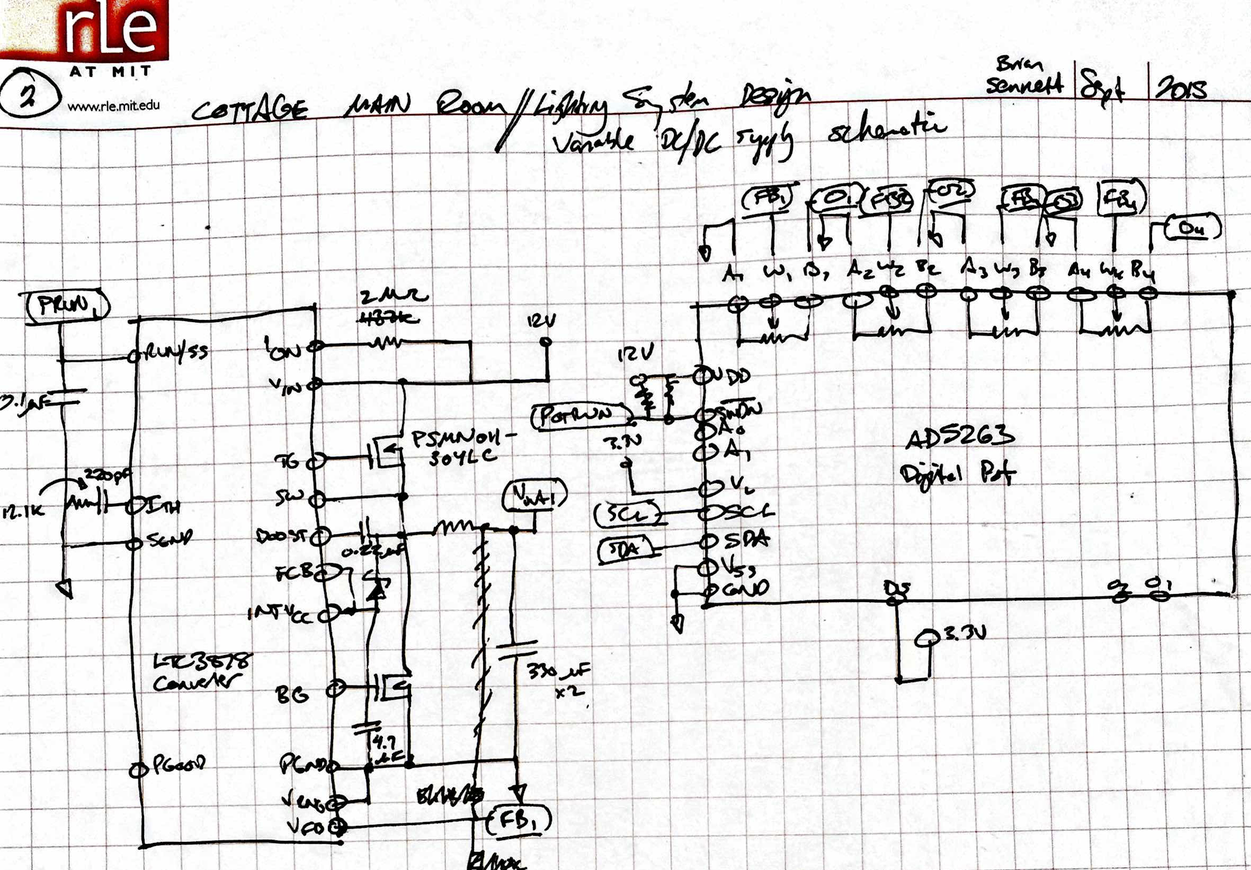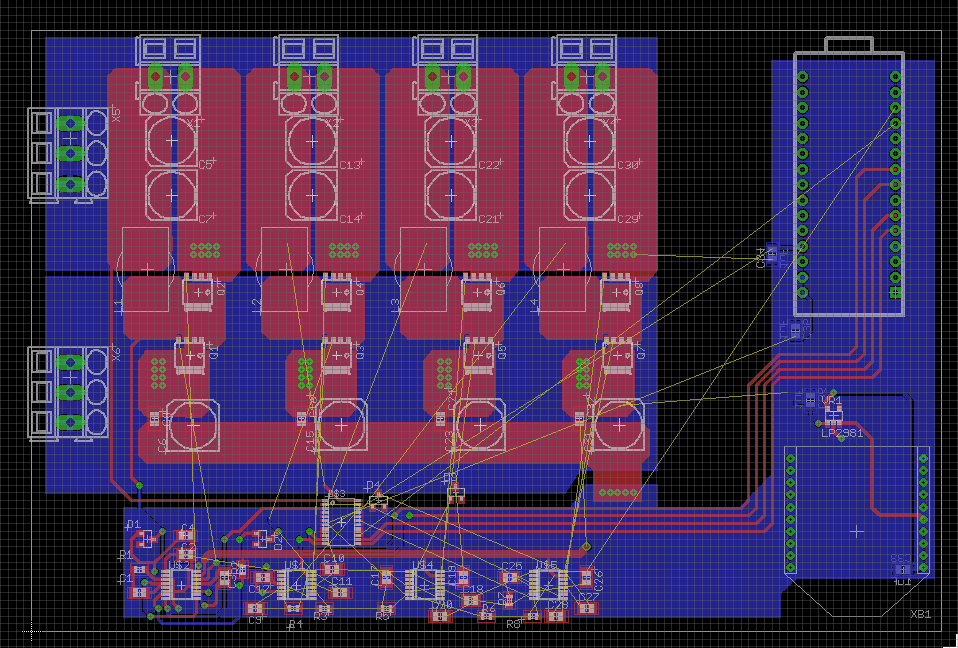

Multi-Zone Lighting System Lake house
My family's lake house features a large family room that needs additional lighting to illuminate dining and common areas. I chose to build a low-voltage halogen mini-spot system that consists of power and remote-control modules to form a multi-zone lighting controller.
The system needs to be relatively inexpensive (target costs are $300 for electronics, $100 for enclosures, and $200 for luminaires and lamps). It should have multiple zones so as to conserve energy and allow isolation of parts of the large room, as well as tailor intensities to occupants' needs. Using a low voltage avoids the risk of electrocution and reduces losses.
I chose a modular approach to save costs; many elements of the project (PCB, outsourced enclosure machining or printing, front panel) would benefit from economy of scale. The power module will use standard 120VAC household supply, and output three or four zone circuits at 12VDC to serve sets of fixtures. The remote controller will be battery-powered and compact enough to mount on a wall or other convenient location. It should be wireless, since we don't need the hassle of more wires, and that will enable very flexible placement. An LCD and soft buttons plus a rotary encoder will be the UI, which should allow fine control of dimming levels for each or all zones, plus recalling of presets. (I don't plan to be able to create presets on the remote control.)
October 1, 2015
The first part of the main power system plan is to convert the 120VAC to 15VDC through an off-the-shelf AC/DC converter. The reason to choose buy over make, in this case, is a concern over the safety of 120VAC (as before) plus the fact that the power level required for an entire system is high enough (500W-1kW) to require much more expensive components which can be economized by the scale of a power-supply manufacturer. Such power supplies can be obtained from Mean Well through Jameco for less than $100.
After the AC/DC, each zone has a DC/DC down-conversion that varies the output voltage with the desired intensity. The DC/DC converters are centered around an LTC3878 switching converter controller, with appropriate passive components (inductors and capacitors). The output voltage is varied by a resistor divider, which in this implementation is created by an AD5263 four-channel digital potentiometer, in turn controlled by an I2C bus from a microcontroller.
The Arduino Nano was chosen as the micro for the power module. The Nano is, of course, an Atmel ATMEGA328 on a simple eval board. The choice of mini-board ("daughter-board") form was motivated by simplicity of implementation the first time around. It's easily programmable and already equipped with a bootloader, so I don't have to worry about placing my own chip and bootloading it through ICSP. It also allows development separate from the main board. I plan to use either an ATMEGA328 or MSP430 as the micro on the remote, which will force an on-board micro due to its small size.
October 19, 2015
Almost done routing first-round! 11 airwires left, down from hundreds. After routing I will run a ULP to set trace widths wider for power rails, narrower for some low-current nets. Narrowing trace widths to 0.01 inch helped routing in tight spaces. I may choose to use 2 oz. copper rather than 1 oz., which would reduce the board size and may be cost-effective. This would require re-routing the power polygons but not much re-routing in the controller area, which was the toughest.
Electrostatic Sensor Research LEES, RLE@MIT
Using the same type of technology as most touch interfaces, I've developed a system that can sense the material makeup as well as the shape of objects brought within roughly a quarter-inch of a surface. Furthermore, multiple surfaces in a room or building can sense human occupancy and motion.
My Masters of Engineering thesis at MIT caps off generations of previous work in capacitive sensing, and combines concepts of both short and long range capacitive sensing. The thesis is not yet available publicly in digital form, but the abstract is below.
This work presents several types of novel long-range capacitive sensors that enable better detection of how people move through buildings, presenting ample opportunity for smart lighting and utility control. Various arrangements of sensors on walls, ceilings, and floors turn building surfaces into sensor systems. These systems offer presence and motion detection, and each sensor can also act as a short-range imaging and material detection device. The ability to detect materials in occupants enables this sensor system to act as a non-intrusive security scanning device, improving the confidence of security personnel and easing concerns of travelers and building occupants. Each component of the sensor is modeled physically for electrostatic simulations, and electrically in circuit form. These accurate simulations validate experimental data and confirm a lumped-capacitance system model, as well as provide a tool for designing sensor systems prior to installation.


Studio Guest Panels WMBR® 88.1FM
A simple building project to beautify and update the control panels in B-Studio at WMBR®.
Each panel has two headphone jacks and corresponding potentiometers to control volume. In addition, cough and talkback buttons allow future functionality. Icons and text are laser-etched into the anodized aluminum panel.
The panels were first designed in SolidWorks® with etched graphics included, then processed for CAM and machined with an 1/8" endmill on a Haas® VF-2 vertical machining center. (Major thanks to Andrew Carlson for his machining help!) The graphics were etched on a Universal Laser Systems PLS cutter. Four bolts were passed through the panels and the countertop to anchor the panels, and the jacks and potentiometers were wired to existing headphone amplifiers in the studio.